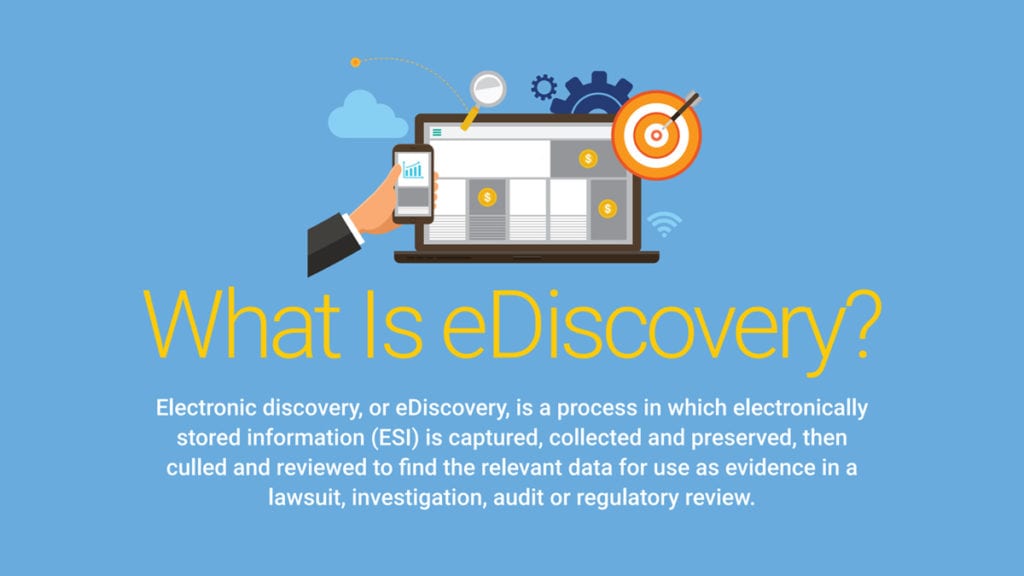The BIA eDiscovery Infographic is a great tool for attorneys and IT professionals alike.
The eDiscovery infographic is a useful resource to get an at-a-glance view of the overall eDiscovery process and for attorneys and IT professionals to better understand the stages of the overall litigation process as it relates to Electronically Stored Information (ESI).

What Is eDiscovery?
Electronic discovery, or eDiscovery, is a process in which electronically stored information (ESI) is captured, collected and preserved, then culled and reviewed to find the relevant data for use as evidence in a lawsuit, investigation, audit or regulatory review. The eDiscovery Infographic describes that process.
The eDiscovery Reference Model (EDRM)
The eDiscovery Infographic represents the EDRM which is the original visual framework for eDiscovery
- Information governance: Getting your electronic house in order to mitigate risk and expenses should eDiscovery be necessary, from the initial creation of ESI through its final disposition. This can include outlining and implementing data policies, assessing privacy risks and improving the organization’s security posture, mitigating legal risks, improving IT efficiency and more – all to ensure unified governance.
- Identification: Locating potential sources of ESI and determining their scope, breadth and depth. Custodian Questionnaires (CQs) aid counsel in winnowing down a broad custodian list to those who have the most involvement or are closest to the matter. Early case assessment (ECA) allows counsel to quickly glean insight into your data to help you determine case strategy, assess risks and predict cost.
- Preservation: Ensuring that potentially relevant ESI is protected against inappropriate alteration or destruction. This may include issuing legal hold notifications to custodians instructing them not to delete any data that might be relevant to the case.
- Collection: Gathering ESI in a forensic and defensible way, from all devices and platforms with potentially relevant data, for further use in the eDiscovery process (processing, review, etc.).
- Processing: Reducing the volume of ESI and, if necessary, converting it to forms more suitable for review and analysis.
- Review: Evaluating ESI for relevance and privilege. Tools like technology assisted review (TAR), an iteration of AI, automatically classify large volumes of documents and are redefining the way we review ESI and how eDiscovery is performed.
- Analysis: Evaluating ESI for content and context. Searching for key patterns, topics, people and discussion.
- Production: Delivering ESI to others, using the appropriate forms and delivery mechanisms.
- Presentation: Displaying ESI before audiences (at depositions, hearings, trials, etc.), especially in native and near-native forms, to elicit further information, validate existing facts and positions or persuade an audience.
eDiscovery Drivers
- Litigation
- Regulatory compliance
- Investigations and audits
What’s Discoverable?
Discoverable data is data that can be used as evidence in litigation.
- Audio/visual recordings
- Emails
- Data stored in the cloud or on backup tapes or hard drives
- Social media content
- Phone records
- Chat conversations
- Text messages
- Photographs
- Apps
- IoT data
- Computer documents (even deleted docs)
- Company databases
- Metadata (data about data)
- Website content
Benefits of eDiscovery
- Helps you find the smoking gun: Find the key documents needed to make your case.
- Assists with case strategy: Prepare for your legal matter and ensure your case is worth taking to court.
- Allows for business intelligence: Reference data from previous matters to inform decisions about future cases.
The BIA eDiscovery Infographic can be printed and kept close-by and handy for easy access to key information about the overall eDiscovery process.
The Value of Managed eDiscovery Services article is also a good resource to use, along with this infographic, when determining the value of a particular provider’s Managed eDiscovery Services offering.
